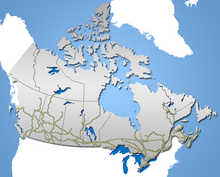This article includes a list of general references, but it lacks sufficient corresponding inline citations. (February 2008) |
| Railways in Canada | |
|---|---|
 Major lines of the Canadian railway network | |
| Operation | |
| Major operators | Canadian National Railway Canadian Pacific Kansas City Via Rail |
| Statistics | |
| Ridership | 84 million a year[1] |
| System length | |
| Total | 49,422 km (30,709 mi) |
| Electrified | 129 km (80 mi) |
| Track gauge | |
| Old gauge | 5 ft 6 in (1,676 mm) |
| Main | 1,435 mm (4 ft 8+1⁄2 in) |
| Part of a series on |
| Rail transport |
|---|
 |
|
|
| Infrastructure |
|
|
| Service and rolling stock |
|
| Special systems |
|
|
| Miscellanea |
|
|

Canada has a large and well-developed railway system that primarily transports freight. There are two major publicly traded transcontinental freight railway systems, Canadian National (CN) and Canadian Pacific Kansas City (CPKC). Nationwide passenger services are provided by the federal crown corporation Via Rail, and three international services to the US by Amtrak. Three Canadian cities have commuter train services: in the Montreal area by Exo, in the Toronto area by GO Transit, and in the Vancouver area by West Coast Express. These cities and several others are also served by light rail or metro systems. Only one (Toronto) has an extensive streetcar (tram) system. Smaller railways such as Ontario Northland Railway also run passenger trains to remote rural areas. The Rocky Mountaineer and Royal Canadian Pacific provide luxury rail tours for viewing scenery in the Canadian Rockies as well as other mountainous areas of British Columbia and Alberta.
Canada has 49,422 kilometres (30,709 mi) total trackage, of which only 129 kilometres (80 mi) is electrified (all urban rail transit networks). Canada uses 1,435 mm (4 ft 8+1⁄2 in) standard gauge track for the majority of its railway system. The exceptions to this are small lines isolated from the main North American rail network used in resource industries such as mining or forestry, some of which are narrow gauge, and the streetcar and heavy-rail subway lines of the Toronto Transit Commission which use a broad gauge of 4 ft 10+7⁄8 in (1,495 mm).
- ^ "Canada's Passenger Railways: Moving People". www.railcan.ca. 6 October 2016. Retrieved 2 December 2019.